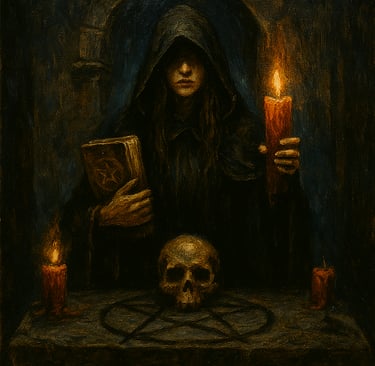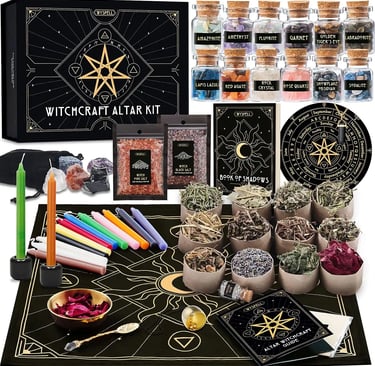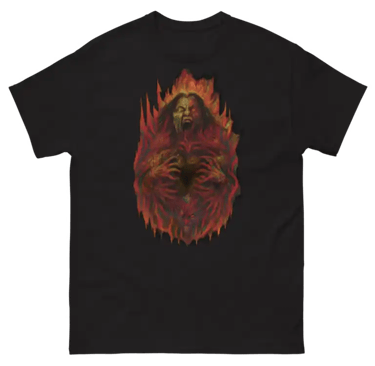The Power of Witch Spells: Ritual History
Discover the history and power of witch spells — from ancient rituals to modern magic. Explore protection, love, and prosperity spells still in practice today.
SPELLS
Marcel Helmar
10/10/20255 min read


Caption: A witch prepares her ritual with spellbook and candlelight — a timeless image of witch spells and Gothic horror.
Witch spells are both relic and living flame. They are the whispered charms etched into clay tablets thousands of years ago, and they are the candlelit rituals performed in bedrooms and backyards today. To speak of witch spells is to speak of continuity — a thread of intention that runs through centuries, binding the ancient with the modern.
They are not merely superstition or folklore. Witch spells are acts of focus, ritualized language, and symbolic gesture — ways of shaping the unseen currents of life. They are history written in smoke and salt, but also a living practice, evolving with each generation that dares to speak words of power aloud.
Ritual History of Witch Spells
Ancient Civilizations
The earliest witch spells were not called “witchcraft” at all. In Mesopotamia, clay tablets recorded incantations against illness and misfortune, invoking gods and spirits to protect the living. In Egypt, spells were carved into tomb walls and written on papyri, guiding the dead through the afterlife. The Greeks inscribed curse tablets — thin sheets of lead etched with names and pleas for divine intervention — buried in graves or wells to bind enemies.
These were not fringe practices. They were woven into daily life, a way of negotiating with forces beyond human control.
Medieval Grimoires
By the Middle Ages, witch spells became both feared and coveted. Grimoires — handwritten books of magic — circulated in secret, filled with instructions for summoning spirits, crafting talismans, and invoking protection. The Key of Solomon and other texts blended Christian prayers with older magical traditions, creating a hybrid form of ritual practice.
At the same time, fear of witchcraft grew. The Inquisition and witch trials cast spells as dangerous heresies, punishable by death. Yet even under persecution, the knowledge endured — hidden in folk remedies, whispered charms, and coded symbols passed down through generations.
Modern Witchcraft
The 20th century saw a revival. Wicca and neo‑pagan traditions reclaimed witch spells as sacred tools of empowerment rather than instruments of fear. Rituals once whispered in secrecy became part of open covens, festivals, and published books.
Today, witch spells are as likely to be found in a leather‑bound grimoire as they are on a glowing phone screen. The digital age has not diminished them — it has amplified them, carrying ancient practices into new forms of community and expression.


Full Witchcraft Altar Kit
$39.99 - Amazon
Begin your spellcasting journey with this complete witchcraft kit — over 100 ritual tools, crystals, herbs, and candles designed for beginners and seasoned witches alike.
Types of Witch Spells
Protection Spells
Protection spells are among the oldest and most enduring. From salt circles to iron charms, witches have always sought to shield themselves and their communities from harm. A protection spell might involve carrying a protective herb like rosemary, inscribing a sigil on a doorway, or lighting a candle to ward off negativity.
Love Spells
Love spells are perhaps the most infamous. They range from simple charms to attract affection, to complex rituals meant to bind two souls together. While often sensationalized, many love spells are less about controlling others and more about cultivating self‑love, confidence, and openness to connection.
Prosperity Spells
Prosperity spells focus on abundance — not only money, but opportunities, health, and growth. A witch might craft a money bowl filled with coins and herbs, or burn green candles dressed with oils to draw prosperity. These spells reflect the universal human desire for stability and flourishing.
Banishing Spells
Banishing spells are about removal — casting out negativity, breaking unhealthy attachments, or cleansing a space of lingering energies. They can be as simple as writing a harmful habit on paper and burning it, or as elaborate as a full moon ritual with chants and symbolic tools.
How to Cast Witch Spells Safely
Tools
Common tools include candles, herbs, crystals, and ritual knives (athames). Each tool is symbolic, focusing intention. A candle becomes a beacon of transformation, a crystal a vessel of energy, a herb a bridge to ancestral knowledge.
Ethics
The ethics of witch spells are debated, but many practitioners follow the “rule of three” — that whatever energy you send out returns threefold. Consent is central: casting a spell to harm or control another is seen as dangerous, both spiritually and karmically.
Intention
Above all, intention is the heart of spellcasting. Without focus, a spell is just words and gestures. With intention, even the simplest act — a whispered phrase, a tied knot — becomes a ritual of power.


The HeartRot Sigil Limit Tee
The HeartRot tee is a wearable hex — soft black cotton, marked with the truth that love and rot are inseparable.
$22.50
Witch Spells in Modern Culture
The digital age has given witch spells new life. On TikTok, “WitchTok” creators share quick rituals, crystal grids, and spell jars with millions of viewers. Etsy sells spell kits and handmade charms. Online grimoires and forums allow practitioners to share knowledge across continents.
Pop culture continues to shape perceptions, from The Craft to American Horror Story. While dramatized, these depictions keep witchcraft in the cultural imagination, sparking curiosity that often leads seekers to authentic practice.
Conclusion
Witch spells are not relics of a forgotten past. They are living practices, shaped by history but alive in the present. From ancient incantations to modern TikTok rituals, they continue to reflect humanity’s desire to connect with forces beyond the visible.
If you’re drawn to the mythic, the ritual, and the Gothic, you’ll find deeper explorations of dark poetry, occult horror, and ritual‑inspired storytelling at Horror & Hexes. There, the spell is not just read — it is lived.
FAQs About Witch Spells
What are witch spells? Witch spells are rituals of intention, using words, symbols, and actions to influence unseen forces. They can be protective, healing, or transformative.
Can beginners cast spells? Yes. Many spells are simple and accessible, such as lighting a candle with focused intention or carrying a protective charm.
Do witch spells really work? Spells work through a combination of psychological focus, symbolic action, and spiritual belief. For practitioners, they are powerful tools of transformation.
What tools do I need for spellcasting? Basic tools include candles, herbs, crystals, and a journal. However, intention is more important than any physical object.
Are witch spells dangerous? Spells are not inherently dangerous, but misuse — especially attempts to control others — can have ethical and spiritual consequences.
Subscribe to our newsletter
Enjoy exclusive special deals available only to our subscribers.
About the Author:
Marcel Helmar is a cinematic occult artist, writer, and founder of Horror & Hexes. His work blends ritual symbolism, folk horror, and studio‑grade printmaking to produce limited art drops, immersive essays, and practical ritual guides.
Marcel’s writing and visual practice have been used by filmmakers, podcasters, and indie publishers to create atmosphere and authenticity; he teaches workshops on image making, lore research, and publishing for dark‑culture creators. Visitors can browse his gallery, read deep‑dive essays, or join the mailing list for exclusive drops and process notes.
Connect
Explore dark tales and ritualistic mysteries here.
Support
+1-337-718-0155
© 2025. All rights reserved.
Flesh Catechism T-Shirt
Eat Your Heart Out
$22.50

